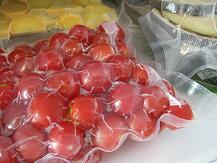 We are often asked, what is the shelf life of products packaged with stand up food pouches? Our first reply is, "What are you packaging?" Is it 6 months, 1 year, forever? The key thing with all "shelf life" questions is oxygen. The second is using barrier film, laminated barrier film that is used to produce standup food pouches. Traditional bags that many are used to such as sandwich bags, garbage bags, shopping bags, etc are not made with barrier film, so if you remove the oxygen and squeeze it really tight, etc, etc, within seconds oxygen will flood the bag. Once oxygen hits the product inside any bag, the "shelf life" ticker has begun.
We are often asked, what is the shelf life of products packaged with stand up food pouches? Our first reply is, "What are you packaging?" Is it 6 months, 1 year, forever? The key thing with all "shelf life" questions is oxygen. The second is using barrier film, laminated barrier film that is used to produce standup food pouches. Traditional bags that many are used to such as sandwich bags, garbage bags, shopping bags, etc are not made with barrier film, so if you remove the oxygen and squeeze it really tight, etc, etc, within seconds oxygen will flood the bag. Once oxygen hits the product inside any bag, the "shelf life" ticker has begun.
Standup food pouches, also known as stand up food bags, or even food grade bags, are made from multiple layers of barrier film laminated together then sealed. This lamination and sealing creates a structure that provides actual barrier properties that protect from moisture, vapor, odor, etc. Further, laminated film is much stronger than normal film like I described above, so it can be converted and formed into pouches that stand erect, are puncture resistant, and very resilient.
However, everything goes back to oxygen getting to your product. If your product is made with a lot of preservatives or coatings, this can effect how long it will take oxygen to degrade your product. If your product is all natural, raw, etc...that too will react to oxygen differently and effect the shelf life.
So what are your choices? Many will inject nitrogen gas (known as a flush) that pushes oxygen OUT of the stand up food pouch while it is being packaged and sealed. This is done with particular equipment and is fairly common among contract packagers who package items for a living. Others will pull a vacuum...or pull all of the oxygen OUT of the package, which definitely keeps the contents fresh "until" the food pouch is opened...but if you've ever seen anything packaged where a vacuum has been pulled on the bag, it looks distorted and ugly.
Ahhh, until the pouch is opened, and once again oxygen comes flooding in and the shelf life ticker begins once again. So what are your choices? For some products and companies, they insert a small packet of an oxygen absorber or scavenger. These are often in beef jerky, crackers, snacks, etc. These are effective for a few reasons...they do what they are made to do, absorb oxygen, and eliminate the need to push or pull the oxygen out of a pouch. However, once again, when the bag is opened oxygen will enter it. Pushing and squeezing as much as possible and using a robust ziplock will minimize the amount of oxygen and also extend the shelf life.
For those products that cannot have anything inside of a stand up food pouch because some retailers won't allow it, they will need to use a preservative or adjust their expectations or even print on the stand up food bag instructions on how to prolong the shelf life, i.e. remove the oxygen once it is opened, store in a refrigerator or even a freezer...which can also affect the shelf life.
In summary, every product is different. Stand up food pouches, printed or plain, are made with heavy duty barrier film that will protect the contents and keep it fresher for longer. By design, the film used will reduce/minimize/prevent oxygen to get at your product until the pouch is opened. From there, additional steps will need to be taken to prolong the shelf life.





